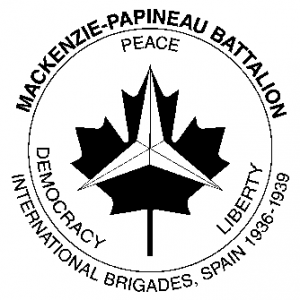The First Volunteers
Hundreds of foreign volunteers were fighting in Spain pior to the formation of the Internation Brigades – mostly in Barcelona in the wokers militias although there also enough foreigners in the Republican forces to be formed into small units by Nationality and attached to regular Spanish units. These were mostly in the Quinto Regimento organized by the Communist Party of Spain. In August of 1936 the Party held a meeting at Aranjuez to discuss the possiblitiy of organizing an International Brigade. This was formally agreed to at a Commintern meeting on September 8, 1936.
Tim Buck and Candian Recruiting
Tim Buck had participated in the Aranjuez meeting. On his return to Toronto he met with the Communist Party of Canada Central Committee where a plan to enlist volunteers was agreed to. The Communist Party of Canada was to become the principle recruiter in Canada (and worldwide). It was certainly not the sole organization publicizing the cause of the Spanish republic – The Committee to Aid Spanish Democracy was the main fund raiser and the Comunist Party was only one of the many organizations covered by their umbrella. But the Party was the main recuriting force although one needn’t have been a communist to join. Indeed, anyone who was not a Trotskyite was welcomed and about 20% of the Canadian contingent was non-communist.
Local recruitment committees were rapidly established. By April 1937 about 500 volunteers had been enlisted. In that month however, the Canadian Government, following the US lead, passed the Foreign Enlistment Act. The act made participation by Canadians in a foreign sevice illegal and while no country was mentioned it was clearly directed at the recruiting for Spain. Recruitment continued but underground. In early summer, Mackenzie King travelled to Germany, meeting with Hitler and other members of the Nazi Party and remarking in his diary on the favorable impression thay had made on him. Returning to Canada he would stiffen Canadian Government opposition to the recruiting ordering that all Canadian Passports issued after August 10 be invalid for entry to Spain. This did not stop recruiting or travel to Spain, it simply made things more difficult.
First Major Action: the Battle for Madrid
The story in Canada was paralleled in other countries. The XIth International Brigade was quickly formed in the fall of 1936, mainly from 
The XIth fought with heavy losses in its first major engagement – the battle for Madrid – losing about half of its 2000 men in fierce building by building fighting on the University grounds at the North East end of the city. In spite of the heavy losses, the brigade held its ground. The impact was enormous. The Nationalist forces were elite Army of Africa units and previously thought to be invincible. The fact that they could be held back was of great importance for the moral of the Republican forces.
New brigades were formed in December, the XIIth and the XIVth with volunteers from France, Poland, Belgium and Yugoslavia. They were also thrown into the battle for Madrid as a new Nationalist offensive opened.
Again they suffered high causalties and again they helped to stop the new offensive.
The XVth International Brigade and the Battle at Jarama
By February 1937, the the XVth International Brigade was formed, consisting of the Slav Dimitrov Battalion, the British Battalion, the Lincoln and Washington Battalions and the French 6 of February Battalion.
Canadian volunteers were arriving in increasing numbers. They would travel to the south of France (their passports were stamped “not valid for travel to Spain”) where they would be escorted by guides over the Pyranees. Once in Spain, they would make their way to Albecete, the headquarters of the International Brigades for training and assignment to their battalion.The increasing Canadian contingent was assigned to the Lincoln Battalion as were a number of volunteers from Latin American countries.
The XVth Brigade was formed in time to oppose a strong nationalist offensive south of Madrid in the Jarama valley, one of the most famous battles of the war. The Nationalist force included the German Condor legions with two heavy machine gun battalions and German tanks and artilliary. Three International Brigades took part: in addition to the XVth there were also the now veteran XIth and XIVth. It was the first major engagement for the two American battalions in the XVth Brigade and for the Canadians assigned to them. The 3 International Brigades were slowly forced back with heavy losses. The British Battalion lost half of its men in a single engagement at “suicide hill”. But the attackers also took heavy losses and Franco was unable to make a strategic breakthrough.
For many Canadians the battle at Jarama was their first action. One of the most famous of the Brigade’s songs (in English at least) was written about Jarama by Alex Mcdade of the British Battalion to the tune of Red River Valley (the version below is McDade’s original, more somber than the better known American version):
There’s a valley in Spain called Jarama,
It’s a place that we all know so well.
For ’tis there that we wasted our manhood,
And most of our old age as well.From this valley they tell us we’re leaving,
But don’t hasten to bid us adieu,
For e’en though we make our departure,
We’ll be back in an hour or two.Oh we’re proud of the Lincoln Battalion,
And the marathon record it’s made,
Please do us this little favour,
And take this last word to brigade:“You will never be happy with strangers;
They would not understand you as we,
So remember the Jarama valley
And the old men who wait patiently.”

